The Past was on Prominent Display at BitSummit 2017, but the Event Feels Like The Future
Look past the loving tributes to retro games and Japan's premiere indie games event feels like the natural, inevitable destiny of video gaming.
This article first appeared on USgamer, a partner publication of VG247. Some content, such as this article, has been migrated to VG247 for posterity after USgamer's closure - but it has not been edited or further vetted by the VG247 team.
If any one fact about this year's BitSummit festival jumped out at me the moment I stepped into the convention fall, it was the near-omnipresence of games inspired by classic works from the 8- and 16-bit eras.
More so than at any other event I've ever attended in all my years in the press, BitSummit eschewed cutting-edge visuals and modern aspirations in favor of a vintage feel. Even PAX events have their share of major publishers peddling big-budget titles; at BitSummit, though, the major players — Nintendo, Sony, and to a lesser degree Game Freak — emphasized independent games. And that, these days, generally means games hewing closer to the classics.
It would be easy, I think, to take a quick glance at the BitSummit show floor and write off the Japanese indie scene as stagnant or lacking in creativity. But the use of tried-and-true visual design doesn't speak to a failure to innovate when it comes to indie game design. It speaks to the limited resources of the market, the modest scale and budgets of the developers, and the fact that it's a lot easier for a two-person team to come up with clever ideas while not having to worry about time- and resource-intensive visuals. Retro visuals have evolved over the past decade from blatant nostalgia-bait to a comfortable springboard for creativity, a pragmatic technical base from which to explore new gameplay ideas.
Here's a quick rundown of just a few of the most promising retro-inspired games I saw t BitSummit — some inventive, some comfortably familiar, but all appealing in their own way.

Zombie Tokyo
A cute rhythm-action game with visuals seemingly inspired by the work of Paul Robertson. The squishy characters and pulsing tempo create a lively game with elements in constant motion. And the designers play around with the nature of the game from level to level; the BitSummit demo alternated between maze-like action to a stage patterned after arcade classic Frogger. George Costanza would be proud.
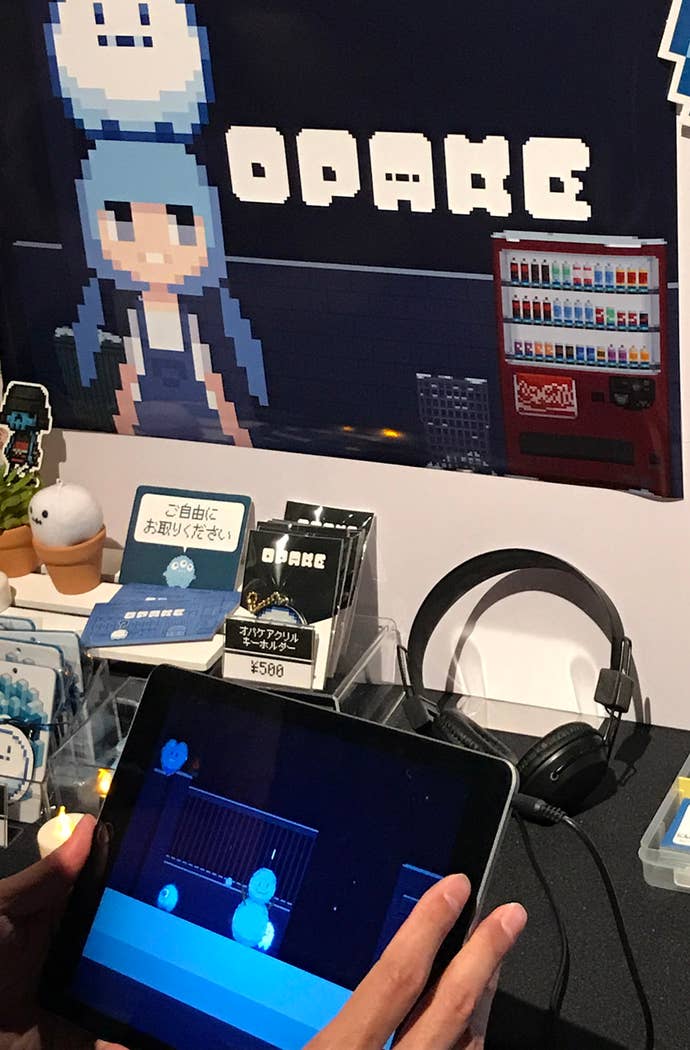
Opake
With a title that plays off the Japanese word for ghost (obake), Opake places players in the role of... a ghost. It's like a cute, mundane take on Prey, in a way: Your goal is to possess objects and help perform simple household tasks. It couldn't look less like Prey, though; its graphical style seems more in line with indie classic Cave Story or Fez, albeit with more proportionate human characters.

Pon Pon Pirates
A novel change of pace, if only in terms of inspiration. Where most retro-chasing games go for an NES, Genesis, or Game Boy-inspired look, Pon Pon Pirates deliberately emulates the look of the cult favorite handheld Neo Geo Pocket Color. If the visual design (with its specific color palette and distinct white cut-out style character outlines) didn't give it away, the fact that the graphical border perfectly resembles a slightly off-brand NGPC definitely would. The action is like nothing you would ever have played on NGPC, though, involving four-player simultaneous competitive play that feels somewhere between Donkey Kong Jr. and Super Smash Bros. Frantic and distinctive.

Iconoclasts
With visuals and play physics inspired by Mega Drive classic Monster World IV married to structure and design reminiscent of Metroid Fusion, Konjak's upcoming platformer looks and plays great. You can read more about this one in my full hands-on preview.

Brave Earth Prologue
This is a heck of a Castlevania tribute. Not the metroidvania games — the olden Castlevania games. Read more about it in my rather effusive hands-on impressions piece.

Momodora V
You know how people are always like, "This game is the Dark Souls of X?" Well, Momodora V isn't the Dark Souls of anything. It's more like... the little girls of Dark Souls. Breaking rather decisively from the previous games in the Momodora series, this one has a sort of bleak (yet colorful) anime style, a methodical pace, precise controls heavily affected by inertia and physics, and a lot of really tough enemies that hit hard. It's very, well, Dark Souls, but with an anime look and a focus on ranged attacks over melee. There's no longer anything even vaguely novel about a game riffing on Dark Souls, but "no longer novel" doesn't mean a Dark Souls-inspired game can't be great all the same — and Momodora V certainly seems capable of greatness, even at this early stage in its development.
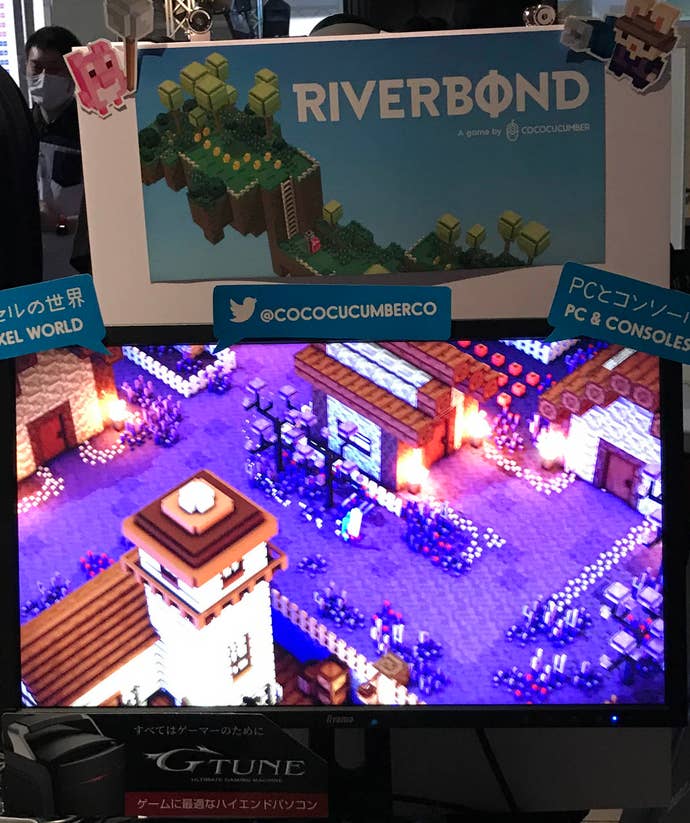
Riverbond
I have no idea what the ultimate goal of this game is, but it plays kind of like Castle Crashers with an isometric viewpoint. Four players team up, wander around towns and arenas viewed from a forced perspective, and beat the almighty living hell out of endless waves of monsters.
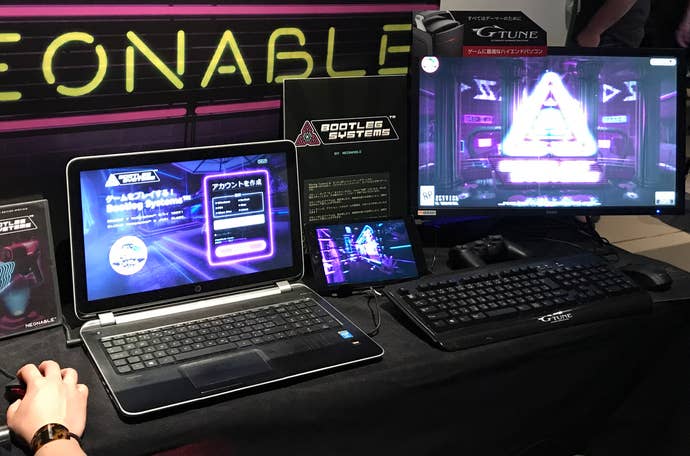
Bootleg System
It looks like Tron, moves like Metroid Prime, incorporates Half-Life 2-style physics, and involves Portal-like puzzles. There's seemingly a little bit of every FPS in Bootleg System, but it manages to be intriguing rather than derivative all the same. The game operates around its unique "combat" system, which allows players to scan just about any inanimate physical object they encounter, then duplicate that item and launch its copies as projectiles. The greater the item's mass, the harder it hits. Since everything takes place inside a computer simulation, a la The Matrix, this makes perfect sense.
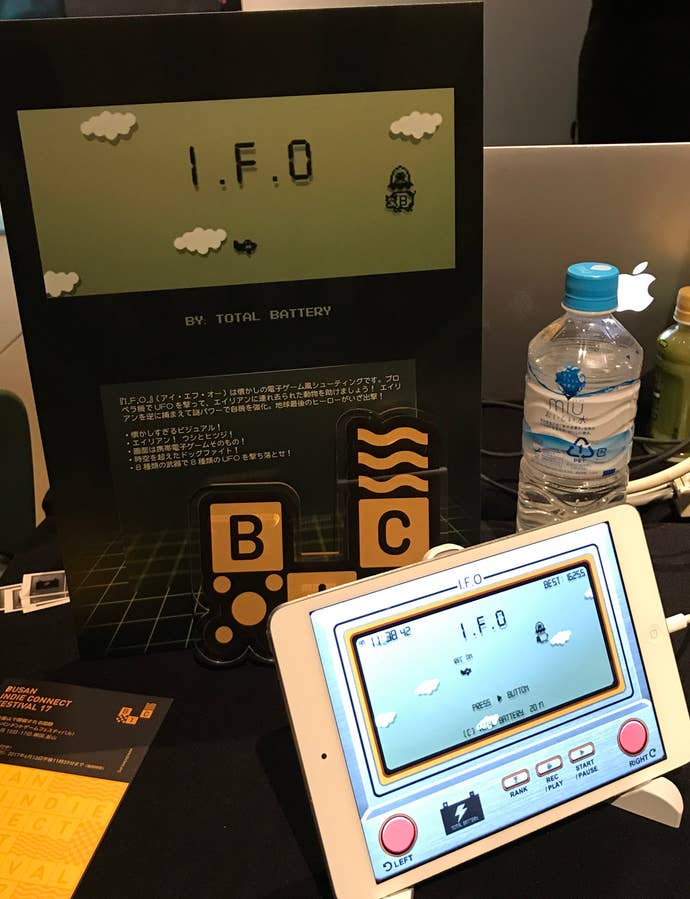
I.F.O.
A simple tablet game done up to resemble an old Nintendo Game & Watch LCD unit. This isn't the first time I've seen a developer adopt the G&W visual metaphor for a mobile game, but it might be the most convincing. It's a nice way to dress up a simplistic creation that can work with monochrome visuals and two-button controls.
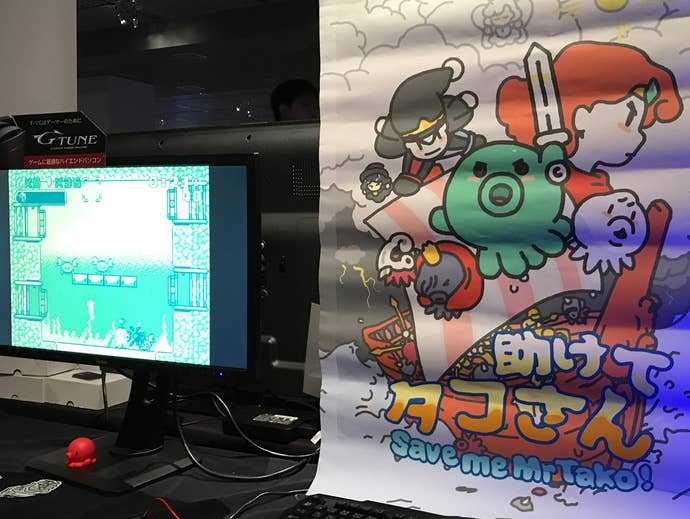
Save Me Mr. Tako!
Speaking of monochrome visuals, I loved the French-developed Save Me Mr. Tako!, which very directly references the original Game Boy. It's not quite an authentic Game Boy work; the resolution is too high, the animation too smooth (betrayed by its French heritage!). However, its mechanics have very definitely been based around the original Wario Land: The titular protagonist here (who looks a heck of a lot like Parodius' Takosuke, who has put in a few appearances on Game Boy himself) can don as many as 50 different hats, each of which serves as a power-up. Wario lost that ability quite a while ago, so it's good to see someone take up the baton.
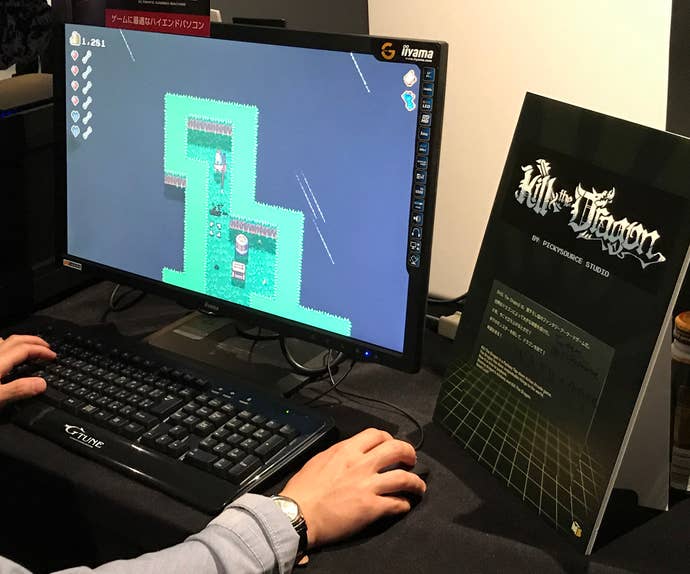
Kill the Dragon
A fast-paced and unforgiving action roguelike cut from the same cloth as Enter the Gungeon and Nuclear Throne.

Cerulean Moon
I saw quite a few games at BitSummit I wanted to play but couldn't due to crowds and time constraints, but none of them filled me with quite so much regret as Cerulean Moon. Well, that's not entirely true; I could have played the demo pretty easily. By default, it's a tablet game, and the tablet version demo was available and accessible throughout the show.
That's because everyone wanted to play the other version on display, which rigged up the PC version to a custom-built cabinet featuring a single button and a spinner — you know, a rotary dial like on the old Arkanoid or Tempest cabinets. The button, incidentally, had no actual gameplay purpose; it was simply there to allow players to "press start" to begin the game. Cerulean Moon controlled entirely with the spinner, which translated its tablet controls (consisting of "move left" and "move right") into incredibly responsive analog movements. (Or so it seemed from my over-the-shoulder perspective), based on the variability with which players moved their little character depending on how much or how little they twisted the custom spinner.
Cerulean Moon's gameplay consists of constantly moving downward through a tower filled with treasures and hazards, but the physicality and sheer responsiveness provided by the spinner knob makes what would be a fairly rote mobile game into a dynamic work reminiscent of ’80s arcade classics, those from before the joystick and D-pad became the standards for gaming.
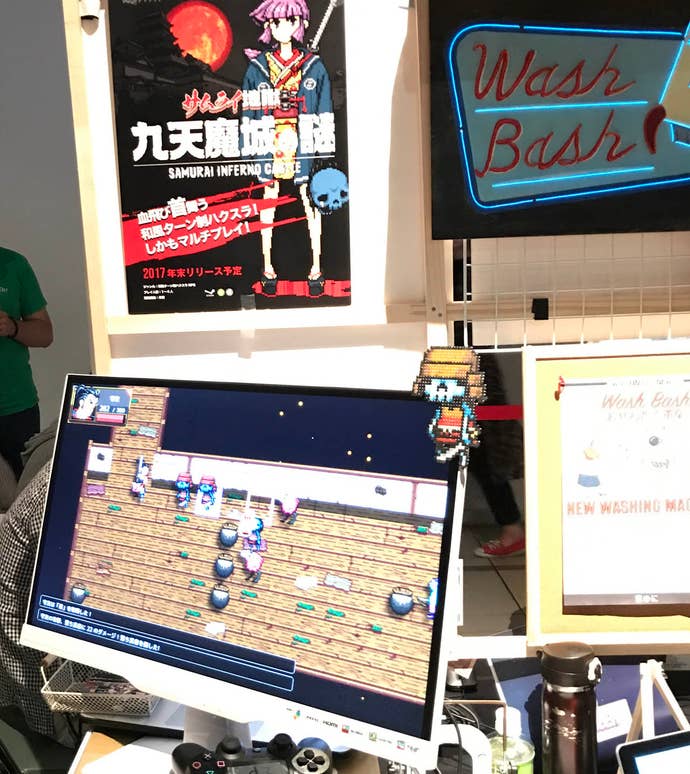
Samurai Inferno Castle
Another roguelike! But this was more of a Mystery Dungeon take on the concept, with turn-based design (rather than real-time action) and all the strategic opportunities that entails.

Kingdom: Two Crowns
And finally, a game whose visuals owe a great deal to Sword & Sworcery. For that matter, Kingdom: Two Crowns's gameplay feels like it owes a dead to Capybara's landmark creation as well. It has a very measured pace, and basically all you do (at least in the demo) is walk back and forth strategically investing cash into villagers and structures in order to build up a kingdom. Building up the townfolk unlocks additional cash with which to invest in further enhancements. It seems pretty low-friction — closer to a "walking simulator" than a traditional strategy game — but there's nothing wrong with that. And besides, the demo ends with goblins stealing your character's crown... so clearly there's some sort of unvoiced narrative to be unraveled in the full game.
Like I said, it would be easy to take a quick survey of these archaic-looking games and declare indie games dead, to assume BitSummit is a graveyard for the games industry. But after spending time with the games at the show and making an effort to get a sense of the bigger picture, I found the opposite to be true. BitSummit represents a promising future for the medium, and for the industry.
The thing that really struck me about BitSummit was that the games on display appeared to be a pretty even mix of American, European, Asian, and Japanese creators. Japan has been fairly slow to join in the indie games movement, for a variety of reasons ranging from the more intimate nature of its doujin scene to the comparatively niche status of PC gaming there. But every year, more and more Japanese devs have been stepping up to show off their small-scale creations... and, as the presence of studios like Inti Creates and Game Freak shows, there are a lot more small studios working in traditional console publishing channels than in the West, where devs tend to be either colossal and hit-driven, tiny and independent, or mid-sized and largely tied to bigger publishers in support roles.
Japan has also been slow to warm to Western games due to the stigma of mediocrity that lingers over them. But indie developers seem to be changing that perception, due both to the sincere quality of their work and to the fact that so many independent games draw on decades of classics hailing from Japan for inspiration. Browsing through Tokyo retro game shops, you'll notice that games originating outside Japan were relatively scarce and unloved in the 8- and 16-bit eras. These days, though, you're pretty likely to spot a U.S. or European-developed indie title being promoted at a shop kiosk; I even heard Shovel Knight remixes being blasted over the speakers at a Super Potato retro outlet last week, which is something I never would have expected.
Much as video games can have an insular, nationalistic reputation, the crowd's behavior at BitSummit suggests that's becoming a thing of the past. There was no real segregation at the show that I could see; attendees of all nationalities were as likely to cluster around an American project like Brave Earth Prologue as around a Japanese creation like Yoshiro Kimura's Million Onion Hotel. Meanwhile, you have new ventures like Dangen Games (headed up by former Capcom and Playism staff) making the localization of Western creations into Japanese the core of their business. It would be irresponsible for me to say, "This is the future of gaming!" But at the very least, BitSummit struck me as a future for gaming — one where the lines between present and past, east and west, and indie and mainstream begin to blur. Where all that emerges is simply a room full of interesting and entertaining games for every platform imaginable. It's certainly the future I want to live in.




_ddwYK80.png?width=291&height=164&fit=crop&quality=80&format=jpg&auto=webp)



